Evolving 'Polly Wee'
1 ...
7891011
1 ...
7891011
|
|
Well done Chris and Polly Wee, what a great test for a new boat.
p.s. nice to see you all at Cobnor. |
|
|
This has been a while coming as I have had to make up for all the back to back, misspent hours building her. Thank you for the votes of confidence above; to quote A Meerkat:
“Ah, you mak mi ver’ cheeks blushink” This topic is entitled ‘Evolving Polly Wee’; just as well ‘cos her first week under sail raised at least as more questions, options and opinions than it answered. So far it seems that she comes out at a similar performance to the Mirror, though I must say that I didn’t have many other boats around during her sailing trials at Cobnor Week, for comparison. That needs qualifying First of all on actually sailing her, she is quite frisky; OK, tender – even with the ballast tanks full. The main problem is that with the protective side decks, there is not much room for a bloke within the body o’ the boat. So, aggravated by the height of the hull, as she heels she rapidly rolls you over the midline, adding to the predicament and the only way to overcome the problem is to hike your nethers up onto the side deck, where you sit as exposed as the tower on Glastonbury Tor:   Once you have accepted being on top of your world, it’s not too bad. You’re above almost all the spray and what she does pick up tends to hit the foredeck and cuddy. Either that or it goes right over the top of the cuddy and from there straight over the lee rail. Good; apart from the sail seriously restricting the view to lee, which could really do with a window. Next and coming with the territory, is her indelicate inclination to partake in the death-roll downwind. This can be much mollified by filling the ballast tanks and sitting in the stern sheets. Sounds like a disaster, doesn’t it? Actually, that is the sum total of her vices and no worse than the average racing dinghy, so I have produced a sort of ‘Live-aboard Laser’ without quite the same turn of speed. To prove it I did take her to sea and managed to stay on top while we had a couple of interesting interludes getting to know each other in the perennially lumpy Hayling Bay. Still, this is not quite what I had intended, as I was hoping she would look after me, rather than me having to look after her. Here are a couple more shots under sail; thank you Grum   Two things should be remembered here, firstly she had to fit between those infernal bollards down the road between us and the river Arun. Secondly, one of the reasons for the build was as a half-scale prototype for a twenty-four foot, standing-headroom, gaff cutter that would be much more heavily ballasted: 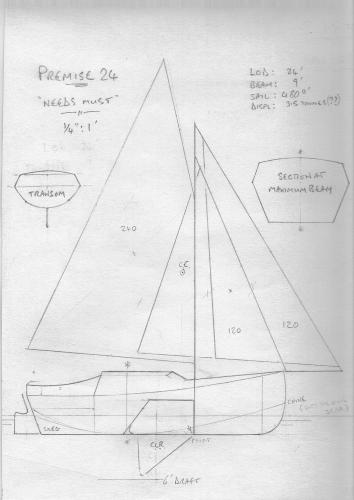  Rather than Polly Wee’s current six-and-three-quarter inch hull draft, an equivalent for the larger boat would increase miss PW’s draft down to at least nine inches bare boat and maybe as much as ten-and-a-half inches in cruising trim. So what’s next? (Apart from ceasing to fuff around and getting on and using her instead; a very reasonable option....) Well she was considerably better behaved with eleven stone of Paulie H. aboard and I was just mixing up some epoxy with a view to making him a permanent fixture, when he jumped ship at East Head and signed up with that well known and jaunty pirate schooner Ever Hopeful. Ballast is obviously the main answer, though when ballasted she already floats down to her marks, with the transom just touching the water. Apart from deliberately loading her down to those equivalent gaffer measurements above with sand bags or such, which is one thing I am bound to do before proceeding to any larger build, I have so far thought of the following: 1. The floor boards currently restrict the volume of ballast with the flexible tanks only half full. I could raise them by anything up to four inches providing perhaps another hundred litres to add to the current one hundred and fifty. Two problems with this, firstly, the floor boards would then be so high as to make living aboard generally and rowing particularly, extremely uncomfortable and I really do not want to go down the path of foot-wells and other tiddly bits. Secondly, she currently takes on ballast passively when the seacock is opened. I am not sure how much of those four inches she would fill without having to actively pump water in. Again, too fiddly to be practical. 2. Plastimo produce longer bags which would add at most another fifty litres, but with no little expense and hacking around of floors to accommodate them; too much hassle for too little extra. 3. Permanent ballast is out as she already seems to weigh at least as much as more than I had hoped. 4. I have three 25 litre water containers – moveable ballast, seems the most sensible option for the time being. I have also considered cutting out waist, (not waste) holes in the side decks to enable me to lean back into the position it seems I presently spend most of my time sitting over the top of; if you get my meaning. Alright, but I have not yet worked out a way of making it look intentional and it would mean easier ingress for oggin in the event of a capsize. It would also mean losing those small buoyancy tanks between the thwart and the side decks, though I could supplement these with a layer of Jeremy’s pink foam worked round the interior of the cockpit sides. Or finally, bugger the bollards; now I know how to build a Premise 12, I already have all the accoutrements, I’ll simply make a new hull, five-foot-six, rather than four-foot-six beam and join a sailing club in Chichester Harbour.  Quote for the week: “I have not failed. I’ve just found 10,000 ways that won’t work.” Thomas Edison Watch this space? CW |
|
|
A sleep aboard that performs as well as a Mirror is not to be sneezed at, and the position on the side deck looks good. More exposed than planned, but definitely gives you a view (except through the sail.)
She certainly looks a real beauty under sail. While initially tender does she harden up as she heels or do you continually feel as if she'll flip any minute? Tim On 26 Sep 2012, at 17:25, Chris Waite [via UK HBBR Forum] wrote: > This has been a while coming as I have had to make up for all the back to back, misspent hours building her. |
|
|
In reply to this post by Chris Waite
Cee Dubbs.
I think, like most of us, you are your own worst critic. You set out to build a boat with specific requirements, and just to make it even harder, set fairly stringent parameters in which, or indeed between which your little vessel had to fit. Then, having completed your mission, in a much shorter time than any of us would have managed, without the aid of computers, CAD systems CNC routers etc or even someone else to hold it while you hit it, and the thing does exactly what it says on the tin, including a round Hayling maiden voyage, you get all sniffy. Have another glass and stop worrying. Now, I wouldn't be me if I didn't have my tuppence worth, and there is another alternative. I know you aren't in favour but here goes anyway. Those bags being cylindrical don't fill the spaces they are lying in. I think you could significantly increase the amount of water ballast by removing the bags and turning the chambers into tanks. The amount of surgery isn't too drastic, the internal floor layout won't change, and its much easier than building another hull. Worth a try ? And the bags will come in handy for the 24 footer. |
|
|
In reply to this post by Timmo
"While initially tender does she harden up as she heels or do you continually feel as if she'll flip any minute? Tim"
I have to tell you that I have developed a distaste for cold water that precludes my being inclined to discover the actual truth. Like most dories, she is certainly very tender intially and I have not yet been able to 'feel' the support she demonstrates in the formal capsize trials: http://www.youtube.com/watch?v=JxIZSSj8QlM&feature=youtu.be (Courtesy of the great Grum and a repeat of the one on the preceding page of this topic) ....as I was saying, apart from the formal capsize trials, she easily comes close to dipping a gunwale on tacking and actually dibbling her mainsheet/boom when rolling downwind* in Hayling Bay and the like, but you can see in the video (which was taken with the ballast tanks full) how hard I had to work to get her down past her gunwale and that she actually supports my weight on the lee gunwale without and just, with the cockpit swamped. Having been brought up on racing dinghies and 'practised' more than my fair share of capsizing, I remain with a reasonably automatic ability to detect any evil intent on the part of the boat, but it does mean having a sufficiently high index of suspicion that precludes the sort of in-flight relaxation I was rather hoping for. Tea, G&T; that sort of thing *For the non sailors - this is a bad thing as next the boom gets swept aft and cocks the sail up at an angle to the wind, rapidly knocking the boat over if corrective action isn't taken smartish. Maybe I'll have a go at trying to capsize her on purpose when the sea as been properly aired next Spring. Don't ask what happens without the water-ballast, it's not pretty CW (Oh, and for those of you on Sutton Broad that day, I will be fitting a mainsheet cleat; Rosie Mae, but will Wee Polly?) |
|
|
Creating higher initial stability could mean sacrificing another of your trademark features (torturing of the minimum numbers of pieces of ply possible to create the hull) in favour of multiple chines to create a rounder bilge.
Wouldn't be as striking and unique though. Possibly slower too. Graham's suggestion to make best use of the space already available for ballast could be a way to go. Also worth looking at what's required to keep you on the windward side within the boat as she heels (just something to brace feet against?) While you can (and do) express your disappointment that Polly Wee hasn't delivered on absolutely every hope you had for her she remains a very good looking and practical design. There are many who would feel that a little extra "interest" under sail is a bonus. Though that formula: 'increased wisdom (age x experience) = increased aversion to cold water', is one I recognise. Could also look on another bright side: your liver can celebrate the reduction in G&T processing it's required to do! See you Saturday. Tim. On 26 Sep 2012, at 22:46, Chris Waite [via UK HBBR Forum] wrote: > "While initially tender does she harden up as she heels or do you continually feel as if she'll flip any minute? Tim" > > I have to tell you that I have developed a distaste for cold water that precludes my being inclined to discover the actual truth. Like most dories, she is certainly very tender intially and I have not yet been able to 'feel' the support she demonstrates in the formal capsize trials: |
|
|
God, Oh God how I hate electronics - I have just spent an hour, or more, answering Graham and Tim and trying to get a link onto the system; then checking the link, it just wiped the entire upload....
And why can others get a whole video screen ready to roll when they add a link and all I get is an http (?URL) address? Spit, just bloody SPIT..... Now where was I? I have the advantage of insider knowledge Grum The water-ballast bags are actually 150 litres each and each is restrained in a sub-floorboard space of only 75 litres, not as you reasonably imagined, a round bag in a square hole. Each is folded in such a way that it can fill the void:  You can see the folds; the port bag as pictured above, being more obvious. And without being screwed Houdini-like under the floorboards to check, I am pretty sure that the system is working, as there is space to peep at the bags and poke a scrawny finger into them once the valve hatch is open:  Do not be a 'Doubting Grumace', but come and poke them for yourself sometime. The set-up seems to be confirmed by her floating down to her marks with myself and some kit on board and the bags flooded. No magic, but merely a rough calculation on the back of a ply off-cut (WBP, of course). Incidentally, now you can finally see that that small piece of holey wood is an over-centre lever to tension the bungy that holds the hatch down. The problem with fixed ballast-tanks is that they not only have a greater propensity to surge (baffles to you too), but they also require a vent and need large waterproof hatches for inspection and maintenance. Worst of all trying to pump them out (at sea) is a lost cause, as with a flat bottom boat such as this, the strum box will rarely be in the right place to be adequately effective. Even in the confines of the narrower bilges forward, the pump is unable to remove the last couple of feral bucketfuls/bucketsful of bilge-water. TimmO, the question of multiple chines Is that there is already such an array of excellent designs that there is no point in a rank amateur like myself poncing off to try and reinvent perfectly serviceable wheels that already exist. The idea - the 'premise' - was to meld as simply as possible, the barge and the dory into a flat bottom hull that would minimize the problems of flatties and sharpies. I also chose to inflict some other parameters such as rowing ability and traversing the streets of Arundel on this particular version. She doesn't seem to slam at all, (even in Hayling Bay) and she has a reasonable turn of speed under sail and oar, as well as bollard popping, so I will allow that those boxes are adequately ticked. Expecting the water-ballast to provide massive stability was, on reflection, just plain greedy, though I wish I had tucked the stern up a tad more, so as not to drag with the extra ballast that might well solve her last problem. I am considering making a separate, large compartment for my liver, or possibly a dumb lighter. So, on to the real-time capsize drills, planned for next Spring, I hope that one or two of you will be prepared to stand by me: http://www.youtube.com/watch?v=Us-TVg40ExM How tenuous can you get? CW |
|
|
All the talk of See-SeeTVs should mean I can link this to the Forward-looking CCTV for rowing in the Technical/Eco Forum, but not from this laptop; not today....
So that you can tell what you’re about to bump into while facing aft, communing with your oars, has reminded me that I did actually walk my narrow boat, not my narrow-boat, down to the slip just the other day to try out the recently installed pedal-yuloh, with adequate success. Can’t say it would fight its way up-stream like a spawning salmon, but nice to face forward and watch the world go by, rather than putting one’s back into it and seeing the world you have just left. Part of my self imposed brief for ‘Polly Wee’ was that she should be susceptible to another Mad Quack project; the forward facing Pedyuloh, while having the oars available for real work should the need arise and the sail set for those rare and beautiful moments when there is some useable wind on your piece of water. The Pedyuloh is a yuloh strung-up to be pedalled while admiring the view ahead: There should be a link to a video of Rosie Mae under pedal here, but Adobe Player is just too Flash for this old fart. I was sick of not being able to take in the view on HBBR river raids and ‘Rosie Mae’ did perhaps as much as a quarter of the 2011 Thames raid under Pedyuloh, complicated by the fact that the apparatus had to be dismantled, including removing the rudder, every time it was necessary to row, or possible to sail. This is how it goes; first bend your oar: 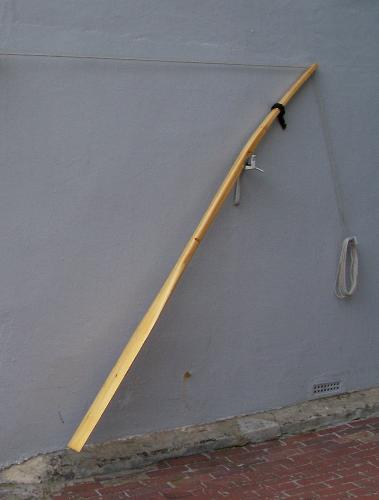 Then stick it on the back of the boat; the tether (in red) prevents the blade diving under the boat:  Notice that it works over the top of the rudder and tiller, which remain in situ and are not only useful for sailing at a moment's notice, but can be used for those tight turns that cannot be achieved by pedalling harder and deeper on one side than the other. Having a centreboard as well, discourages any head, or side wind from blowing you off course. Set up a couple of stirrup type pedals: 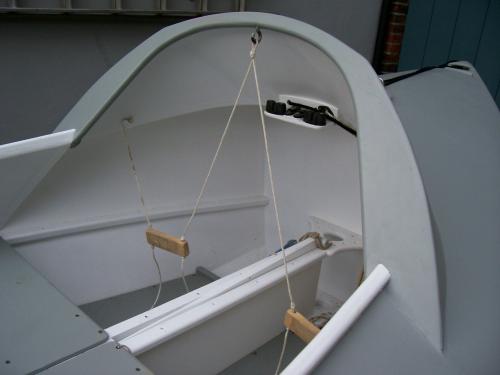 Later you will find that the strops need to be the same length:  Or your feet take it in turns to veer off sideways. For ease of stowage, the wooden bar lifts out, taking the pedals with it. Next a couple of blocks somewhere in the vicinity of the quarters, in such a location that the main sheet will not catch on them and the pedal lines clear everything else. The supports are longer than necessary as I have another secondary job for them – any guesses?  Then a seat, this one is actually a back rest, with little lugs under the front edge, that locate in holes in the thwart:   According to one real engineer, these should be ‘radiused’; otherwise they may not locate properly, allowing you to rip the ply round the holes, while demonstrating your design to your chums. Beating them savagely into a right angle with a hammer and a vice, is not actually the right answer then?  The strap-strop allows the back to retain a comfy (Jeremy) cushion that does not escape while you’re pedalling your bony old nethers off:  Several sets of holes allow various positions and as the starboard half of your thwart is removable for bunk purposes, you have a camping seat to sit round the fireside of an evening, reminiscing with the gang, over a beer:  Setup lines from the yuloh handle through the blocks and run them to the strops on the back of the pedals with rolling hitches, so that you can adjust the length:   And off you go, pedyulohing; or rowing and sailing, pausing momentarily to pop the seat lugs out of their holes and slipping that item forward out of harms way. Oops, there goes another plywood thwart CW |
|
|
Either some ‘card’ has been pulling my tiller extension
Opening and closing this topic Or the months of Mordorian meteorology have bored people sufficiently to allow hits to slip softly past the six thousand mark. You deserve better Anyway, the evolution continues to trickle along in bumps and starts. First of all I lied about the pedals; they still weren’t in the right place. Things seemed reasonable, but somehow I felt like a small boy sitting swinging his legs over the edge of a jetty, rather than the previous proper pedalling sensation. It wasn’t until I was explaining the geometry of the system to yet another poor soul, that I suddenly realized the ‘Pedyuloh’ stirrups were six inches too close to my nethers. They’re OK now though, and while not exactly carved in stone, I have through bolted some eyes under the foredeck. This time it’s just right And not a bear in site: 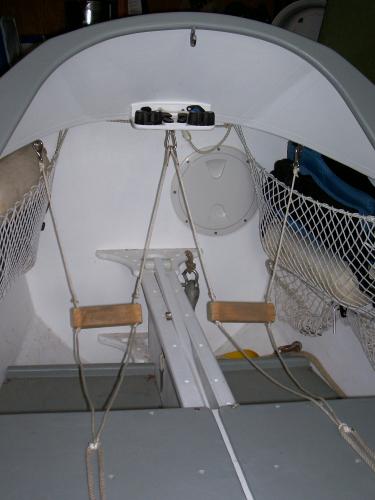 What else? Well, I don’t think I have discussed the rowlocks yet; not vital, but another teensy weensy problemette. Wide inclined side decks are not conducive to mounting rowlocks on the gunwales, as the oar handle is inclined to impinge on the coaming on the return stroke. To avoid this the rowlocks need to be raised a few inches, where they can wait like coral fronds, ready to grab unsuspecting lines and clothing and other items that pass over the out-wale. Time for something folding and Paul Hadley’s experiment with Screwfix stainless fire-door hinges sprang to mind. Here is the result:   Her eight foot oars really make her shift, but are too long to lie demurely on the cockpit sole and these collapsible mounts allow her to wear them ‘Closed-up’ and about ready to go to Action Stations, though I admit the blades are a bit vulnerable to close-quarters combat and inclined to cuff the odd rogue wave smartly across the topknot:  For long voyages and in general, I have under construction, some two-part oars with more robust, flat, seagoing sort of blades, that will fit somewhere less obtrusive. Now there are going to be some bits that overlap with my opinionated little outbursts elsewhere, so skip over them if you’ve heard it all before. Onto bunks; one of the silly things I did in my youth was to work with the Royal Marines for a brief period and they have a saying that “Any fool can be uncomfortable in the field”. This notion can be extended to camping in small boats and ‘Polly Wee’s cockpit is specifically designed to be just long enough to lie-out in. Unless you are related to Houdini, trying to sleep on, or under, the main thwart is also an eye-watering prospect on most dinghies. So ‘PW’s thwart is made in two halves, the port section is well screwed down so that it prevents the aft end of the case flexing as pressure comes on and off the board in a seaway. The starboard side however is removable:   Here you can see that I have a net hammock, or cot berth that rolls up along the starboard stringer when not in use and is clipped along the edge of the case for sleeping purposes, permanently lashed to a strut that drops into place between the aft end of the case and the stern-sheets. It’s comfy, negligible in weight and space, does not take up enough water to dampen a sponge, never mind a sleeping bag and does not need blowing up; my sort of convenience that. How does it clip? Well I bought some stainless ‘R’ clips at Beale last year and cut the crooked leg off each to make a sort of ‘P’:  A rope runs along the edge and through the eyes on these and on setting up they are simply dropped into a series of holes in the rim of the case. Simplz? Well I thought so A couple of other things for the moment; firstly the case of the floating centreboard. Never mind bungees and ropes holding these things up and down, as I have suggested elsewhere, how about a friction device? A small chunk of polythene tube screwed into an edge of the board with a big washer under the head to squash it out till it impinges on the sides of the case sufficiently to stop it floating up, but allow it to knock up if it should hit something. This should be mounted so that the screw can be adjusted while the board is in situ, though while actually retracted takes a little more engineering than I managed. It may be necessary to cut a corner, or chunk, out of the board to provide somewhere convenient to locate it:   Lastly, and it has only taken me some sixty years to work this one out; how to control the rudder blade. ‘Polly Wee’ has a tensionable bungee working on the over-centre principle that when set, holds the blade in either the up or down position with sufficient elasticity that the blade can be lowered with a downhaul This should not be ‘made-off’ (tied), so the blade will knock-up if it hits anything underwater. Otherwise, it will simply float up if the bungee is released, allowing some steerage in shallow water and if the bungee is re-tensioned at this point it stows the blade entirely:   The bungee tensioner is on the blue bauble, being one end of a continuous line whose other end - the wooden toggle, forms the downhaul. Just to prove that I do actually use her as well as dreaming up suspect evolutionary stuff, here are a couple of pictures – a sunny day in January, (yes, there was one) and a weekend trip from Chichester to Southampton Water, with an overnighter in Ashlett Creek; thanks for the picture Al. Sunshine all the way and a following wind in both directions – somebody must have blundered: 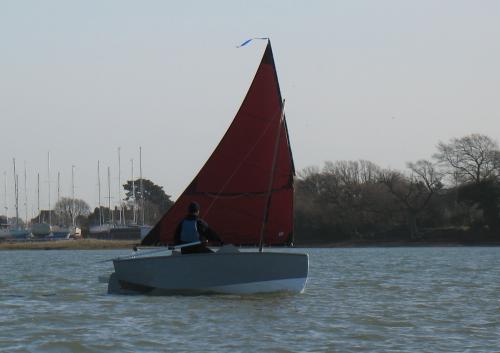 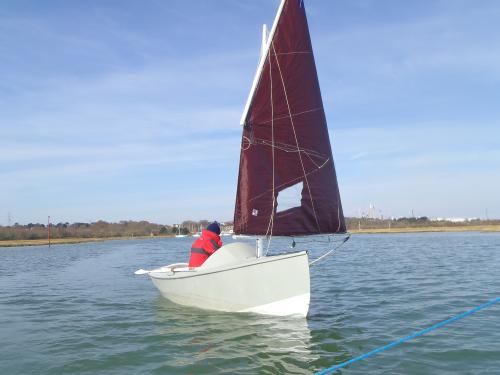 And as Greg queried elsewhere today, she had enough kit and supplies on board that I could have anchored up somewhere for the night. The real point about living on-board is that it doesn’t matter if you’re going over-night or a week, you need a boom tent, bedding, foulies and cooking gear. Once those are on board, the extra victuals and extra clothing really doesn’t make much difference. Having said that, I have to admit to being tempted by the Mill Club at Ashlett And I did eat CW |
|
|
You might be hoping that this old goat would run out of evolutions and stop wittering on. Well I’m getting there, but here is a list of other twiddly bits and pieces that are still occasionally glimmering around the grey stuff:
Sea Oars - flat blades and in this case collapsible as they have no home apart from the cockpit floor. Boom-tent - I do not wish to live forever under polytarp. Gimbals - I've had enough hot food dumped in my lap. Trolley - it's coming and I'll give a demo under the correct heading. Anchor Cleat - I've only just decided the best place for one - the foredeck for instance. Rig Stowage - For river raids and bridges and such. Storm Trysail - Taking cruising seriously, this is a must. Gennicker - Light weather downwind; a relatively easy addition for going the distance. Travelling Crutches and a new Lighting Board would make DCA meetings and others, that much easier. The best laid plans of now and then; I had expected to spend the glorious spare hours of summer communing with ‘Polly Wee’ in the hope of getting to know each other better…. What spare hours, ‘cos I’m stuffed if I noticed any There have been odd moments and I would say that despite my fears for her stability, the more I push my luck, and that has not been so very far yet, the more she lurches unnervingly, but doesn’t actually capsize. This includes one interesting broach, which incorporated a substantial dip of the boom end in the oggin, usually a terminal occurrence; I wasn’t quick enough to react and slithered to an undignified, cursing heap in the lee bilges. With considerable relief, I’m beginning to believe that as Harry-the-Hairy-Horizontal is approached, the water ballast really is heavier than the rigging. One thing I failed to point out when discussing the folding rowlocks, is how they are prevented from popping out of their sockets in any crucial situation. That includes light-fingered passers-by, as well as those fraught moments when the tide sweeps you unerringly toward some moored craft, while the halyard chooses the instant to turn from a neat coil into a writhing heap of vindictive cordage:  Not easy to see, but there’s a small nut and bolt jammed in the hole in the base of the swivelling pin. One of the next most trying things is holding onto the main-sheet for hours on end. I was taught never to tie off a sheet in a dinghy and there are moments when it really doesn’t do to use a jammer, unless you were intending to take a dip anyway. However, many modern dinghies have centre main sheets and having spent some time sailing Lasers, I became very used to their rather unusual rope horse aft (red line), with a single block sliding on it:  The sheet is then led back up to the boom, forward and down:  To a jammer mounted just behind the dagger board. The after end was easy to arrange, but how to set up a jammer that would not obstruct ‘Polly Wee’s hinged centreboard and be demountable to clear the forward end of her cockpit for other activities? I even had a venerable unit that I had previously used on a pet Laser out in the Middle East, but it needed to be high enough and off to one side to clear the centreboard handle. Off to one side actually turned out to be an advantage as that brought it immediately under the boom, which being a balance lug is also off to one side. So it only needed raising six inches or so; also useful, as it would have been too low for the sheet to clear the coaming otherwise. On top of a post then, a removable post; meet my latest crewman – Capability Brown, known to his friends as ‘Stumpy’:   Held in place by a brass peg, (OK, lacing hook), that locates in a hole in the floor board and a split-pin on a string that goes through one of the holes in the rim of the centreboard case:   Come the moment when I do a batch of two-part polyurethane, he will be in for a splash or two and may have to change his surname to ‘White’. What else? One of the trophies of my failed attempt to complete a Solent DCA cruise called the ‘Five Harbours’ was a big bouncy fender left floating in the wake of a passing gin-palace. “I’ll have that”, I thought and so I did; here it is fast asleep in my sleeping bag, while a couple of old hands in the port rack look on with some envy:  You may wonder why, I’m showing you this. Well, it was such eminently pleasant weather:   That it seemed unnecessary to go to the trouble of erecting the boom tent, so wrapping a trusty, dew-proof canvas sheet around my bedding, I spent the three nights of my adventure with my head up under the cuddy and feet down aft. I usually sleep the other way round, but apart from being a smidge tight across the shoulders and the moon peering under my eyelids on a few occasions, it was excellent. It reminded me of my youth in fact Like being back in a pram CW |
|
|
There's not a lot of evolution to report
But, so that I don’t scrape the bottom out of my boat before I’ve ever even finished the top, I’ve rolled her over in the garage to see how close she and the seabed have been getting, with a view to adding some protection. The answer is of course, quite close in places. I never actually got around to any grounding strips or such and that may be because I’m just bone idle, or like to think it was so that I could see exactly where they needed to be. And the answer to that is under the forefoot and at the deepest point of the bilge chines; exactly where you’d expect: 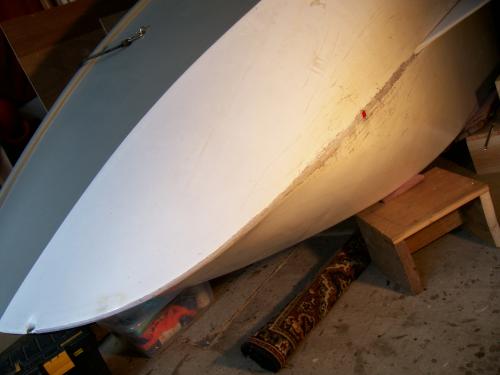  Well, I just wanted to be sure. That little red tab is where there is a limber hole under the mast step – I hope, as it’s not much of a location for a screw. As all the other underwater metal is stainless steel and it’s quite good stuff, I thought I’d continue the theme. A piece of bar, which I profiled-up a bit round the forefoot wasn’t too difficult: 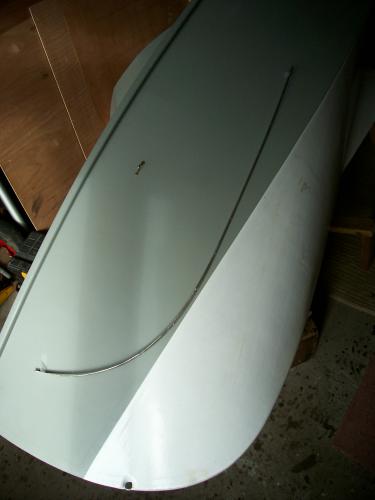  Here it is lying on the side of the hull ready to go and then in situ – epoxied in all its important little places – screwholes and such. While I was searching for suitable stainless – in the Barge Chandlers on the Hamble near Southampton actually, I came upon some very beautiful protective strips and chose the longer ones, which I persuaded into a suitable curve using my usual precision instrument, a large hammer: 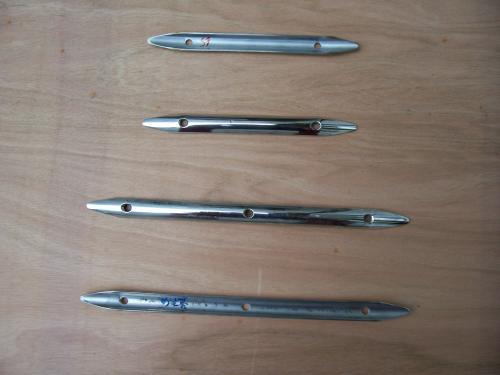 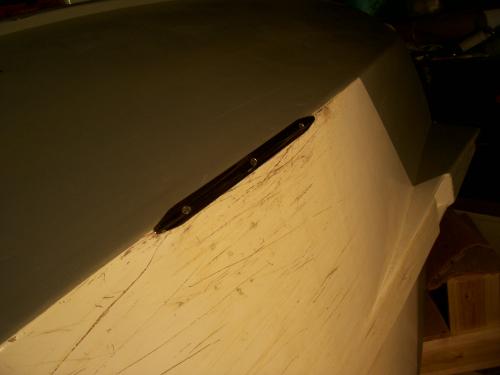 Just the ticket I also reckoned to add something encouragingly robust to the bottom of the centreplate while there’s a bit of it left. Now I know that Alastair uses split copper pipe on ‘Little Jim’s rudder, but ‘Polly Wee’s plate is rather skimpier and I wanted to try and keep any extra profile to a minimum while adding strength. I had thought of a holey stainless plate epoxied into a saw cut, but that is complicated and at the other extreme regarding skimpiness, so for simplicity, I reckoned on a series of screws with the heads filed to comply. Here are the holes for them 18 mm. apart: 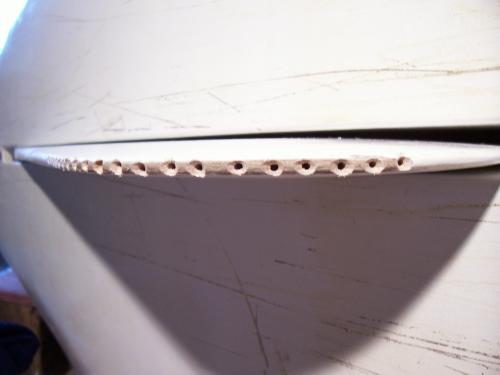 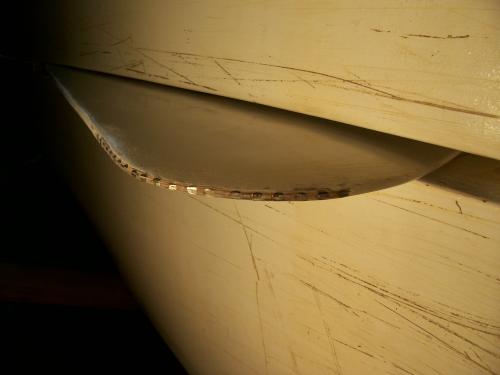 And filled with the screws epoxied in place and filed to blend in seamlessly, sort of thingish. Makes a knuckle duster look quite tame Doesn’t it? CW |
|
|
Just when you think the Great Sod has reduced you to tearing your hair out and you're slumped behind the sofa whimpering, something goes terribly right.
I want to make some collapsible oars (remember the push-button clips? http://uk-hbbr-forum.967333.n3.nabble.com/Buttons-and-Grows-td4027564.html ) on the grounds that mistress Polly Wee is tall enough that anything sufficiently short to lie in the bottom of the cockpit doesn't really reach the water and I'm fed up with having to share the side decks with some eight footers that dangle over the back tempting fate: 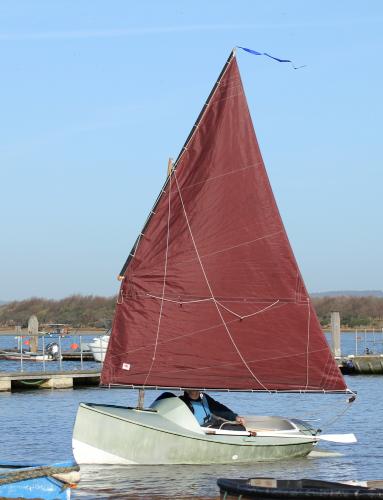 I have been looking out for some 50mm oar collars for months and months now and was on the point of ordering the nearest bigger size with a view to packing them out to fit, when yesterday I had to spend several hours loafing around the Chichester area. I took my bike as it's kinder to my achy old feet and eventually ended up at Chichester Marina's new Chandlers where quite by chance I discovered a small heard of oar collars on a shelf and turning them over, low and behold a brace and a half of 50mm specimens came to light. I could not believe my good fortune. I acquired the brace at some small expense and carried them home, via Cobnor to check that they really did fit in the rowlocks. Today, I could not resist the temptation to see if I could get them over the two inch external diameter alloy tube that will form the top part of the oars and of course they didn't really want to go. That would have been too easy and actually ruined the fact that they're now on there somewhat tighter than ticks: 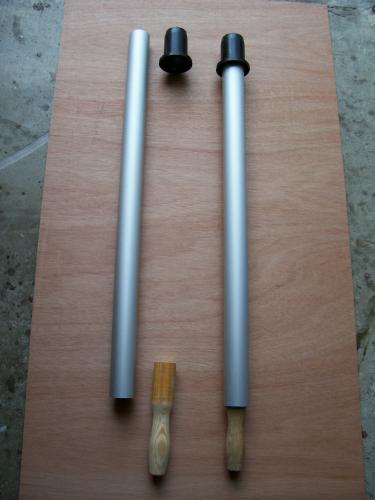 So how did it happen and more to the point, how did it happen without you hearing the distant roar of the frustrated Wait-e-beast; a ghastly cacophony matched only by the din emanating from the dungeons of Mordor? Well, having prepared the receiving end with a file and sandpaper, I mounted the tube vertically in the Workmate, the butt end resting on a spare chunk of ply, itself supported by terra firma. Sorry - I don't seem to have a picture of this bit. I smeared this end with washing up liquid which is a good lubricant that unlike any oil, gets up and disperses in water, leaving only the collar behind - good. Next I got out the hot-air gun and thrusting my left hand into a stout leather work glove, held the collar to the gun on 'high'; easy. Now pliable and ready to submit, I managed to get the first couple of millimetres of collar over the tube. Quickly I fumbled the gun to 'off' and taking another piece of ply with a few smart taps from the hammer I slid the brute fully home. Now cold it's on there tighter than a train wheel on its axle. Here's the kit: 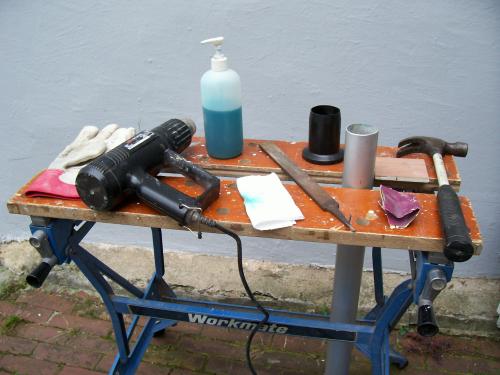 ....and you can actually see the tube in its recipient position. No problems, no having to try six other ways, no broken bits requiring another trip to the chandlers. There must be a God after all At least one for oar collars CW |
|
|
Since writing the last message
It has occurred to me that there may be people out there wondering what a black plastic collar over an alloy tube has to do with collapsible oars. Let me say one thing to you, "Telescopic"! Now here are a few pictures to help with the vision. The idea is that the upper section of the looms (shafts) of the oars will be the alloy tube with the collars at rowlock level: 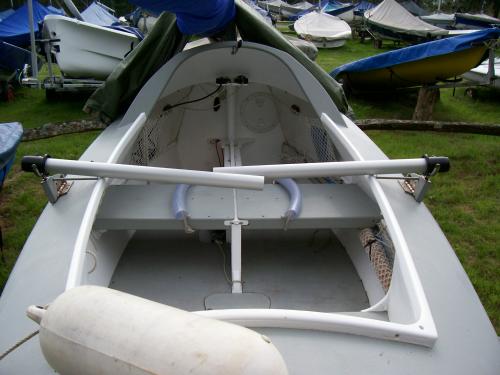 ....need trimming back a foot or so don't they, because there has to be enough room for short wooden handles mounted in their inner ends without overlapping. Enough to make real oarsmen such as the great Christo Partridge wince, but I hate using oars that overlap. It makes my eyes water when I bang my thumbs against my fingers on the return stroke and I am not inserting spacers under a rowlock to improve the clearance; this is a raid dinghy, not a racing scull. At the business end I have chosen some of our local buildy-boys (builders' merchants to you), routine planed softwood to make up short handle-less lower looms with a blade on each. This stuff is about one and three-quarter inch square and rounded off can be made-up to slide comfortably into the alloy tubing. Here are the blanks before subjected to epoxy: 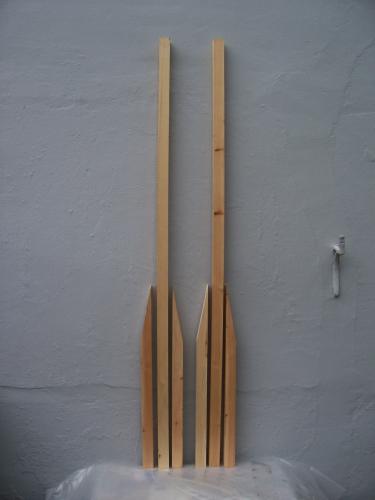 Under epoxification: 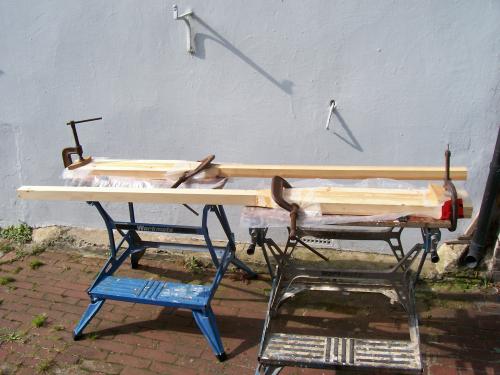 Set and ready: 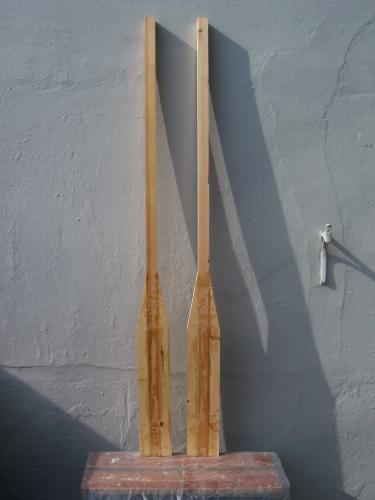 And aligned with the other parts: 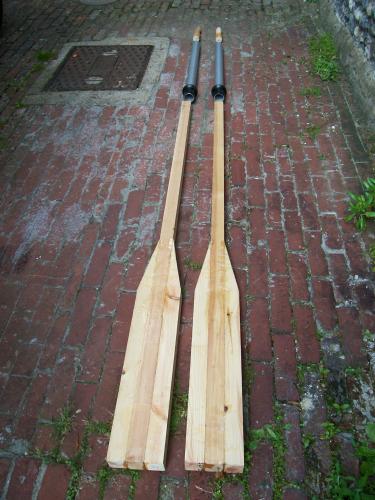 Now all I have to do is shave off a quarter of a ton or so of superfluous softwood, to reveal two beautiful bladed, slim, outer oar-ends. Well there's currently enough spare timber there to make a galley slave beg to be thrown back in the bilges. I prophecy they will be just short enough to lie telescoped under the thwart and extend to a mere inch shorter than the current eight-footers. Other thoughts that have occurred to me are that with flat, not spooned blades it will be possible to use one to scull over the stern and finally I had considered hiding a light line inside each tube to limit the extension, preventing accidental loss of my artistic wood carvery. Oh, and I do have to ransack the garage to find those little button-clips and install them on my elegant creations; a couple of holes in the alloy tubes above the collars and.... Well with those buttons to press It would be "Hey-presto!" Wouldn't it? CW |
|
|
While my fingers are still poised over the keyboard, here is an update on the oar situation.
You know how it's possible to tempt the fates by saying stuff like - "Just when you think the Great Sod has reduced you to tearing your hair out and you're slumped behind the sofa whimpering, something goes terribly right" Well, this is what happens :  The collars looked fine when I'd got them on and for several days afterwards. Then I just happened to notice the lower tapered ends had started to split and eventually.... you get the picture. But don't be downhearted, don't get in a snit In the back of the garage there's a pipe that'll fit: 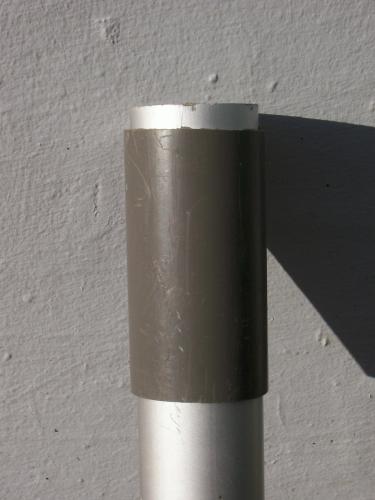 Pity I didn't find it before I rode twenty miles and spent thirteen quid on cheap Italian plastic. Standard 2" ID drain and now all I need to find is some collarly sort of fittings that I can adapt to fix over the upper ends to stop the oars sliding away without permission and a good lathering of silicone sealant to keep them in their place. Well, that's the next cunning plan, anyway. Meanwhile I have been whittling away at the business ends: 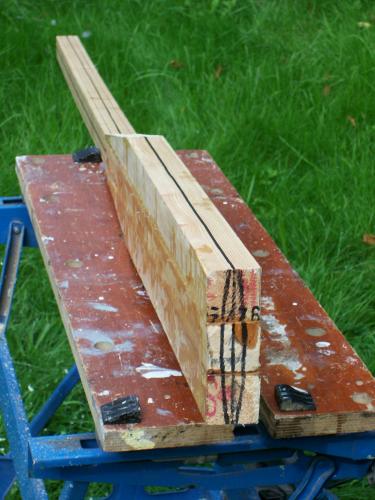 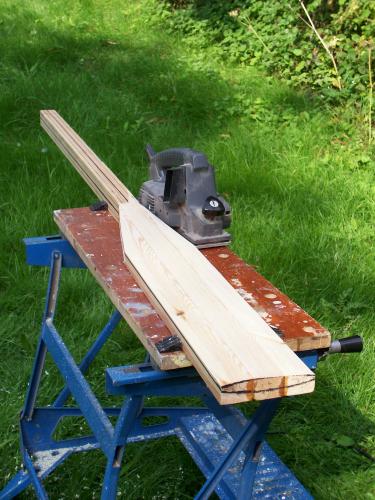 A quick check with a lovely set of Salters Railway Parcel Scales; already down from seven and a half pounds to three and a half: 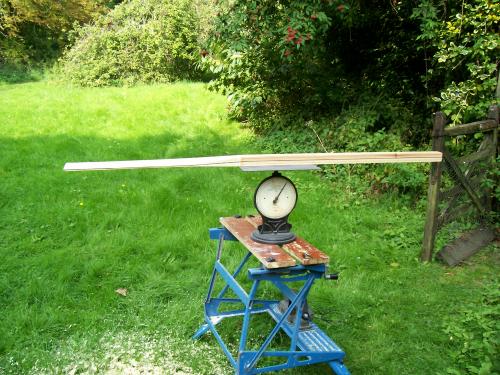 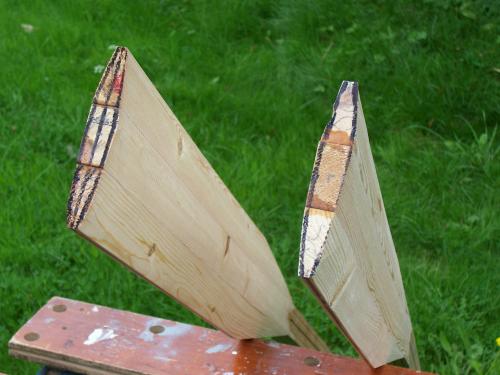 The first pass on the oar blades was achieved with an electric plane, before going onto the spoke shave - very good but you do need to keep removing the shavings that jam under the blade, then starting the big round up of the looms:   The upper ends need to be a snug fit in the alloy tubing, achieved by marking the inside edge with a black marker, scuffling it around and shaving off any black marks left on the wood: 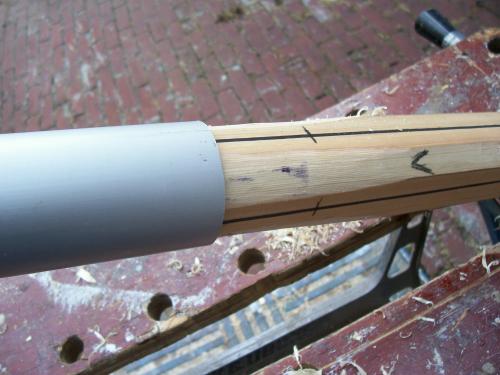 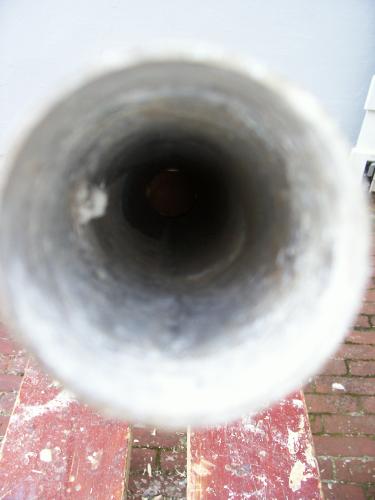 Then tapered to just above the blade, where the cross section is slightly oval - long axis at right angles to the blade, achieved by making cuts to varying depths with a small hacksaw, and planing down until the cut is eliminated, using the spoke shave and that ghastly Surform, my favourite; all checked with a straight edge laid along the surface: 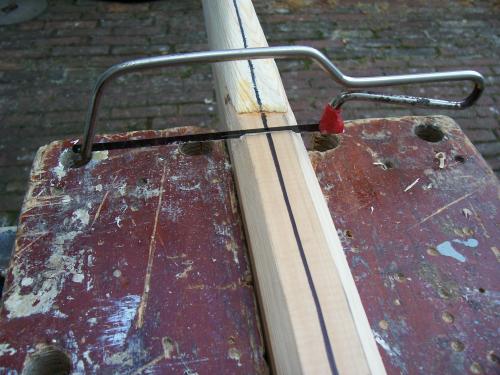 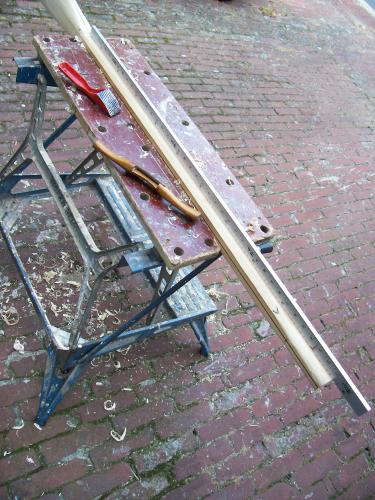 Next slowly, slowly rounding off by eye But that is another story Oar Else |
|
|
Just when you thought it was safe to assume Polly Wee had been utterly Evolved….
Well, I’ve been something of a busy little bee and apart from a momentary hiatus, it’s not over yet. In that hiatus I realized and not for the first time, that I really didn’t have any sensible navigation lights on board. Actually, for a vessel of less than seven metres moving at under seven knots the collision regulations only require (a torch or) an All Round White – the same as for anchoring. No quibbling about the details; you know what I mean. The last time I thought about this LED’s were in their infancy, so I have a nice solar garden lantern which I deign, (well, it’s my body and my boat), to suffice for anchoring in the sort of small corners where one is unlikely to get taken out by a super-tanker. It hangs under the boom, by the mast, during the day to recharge. Anyway, on to sailing at night; I opted for the notion of an all-round, battery powered LED as being the simplest, if I could find a good way of getting it up the rig. Venturing into cyberspace, I came up with this little beauty – http://www.amazon.co.uk/Kampa-601011-Firefly-Lantern/dp/B003JH22MU Three AA batteries and it is meant (meant) to last up to thirty hours, tralaa! So I bought one How to get it aloft? Well the highest point on my balance lug is the peak of the yard itself – reasonably close to vertical too -  And usefully, being a lug, it can be brought down to my level and back up in little more than a trice, so all I needed was clip to hold it on. As part of Polly Wee’s collapsible-oar process, I was forced to buy three metres of 2” plastic pipe. (No, I’m not trying to row with it; it’s as collaring to protect the loom of the oars.) I cut myself a fifteen inch length and sliced it at a fine angle – about as much as one might if taper-joining wood, leaving a couple of inches at one end to hold the body of the lantern. The diameter is too small of course, but ever one to try and make an opportunity out of a disaster, I split the two inch part lengthways, so if held open while the lamp is inserted, it clamps it in an authoritarian grip. Three small points here. Firstly the on/off switch is meant to be ‘water resistant’; see ‘meant’ above. As is the rest of the lamp and someone has suggested silicone grease – good lad, give him a biscuit; actually I wish I'd thought of it myself, he can have the whole packet. Secondly, the transparent plastic dome is not of the finest quality; well what do you expect for a fiver? So I’ve wrapped the seam in black duct tape and thirdly shoved a cable tie round it for good measure (and to stop the lamp sliding further into the pipe). And we shall see To make sure this whole apparatus stays put, I have taken a short length of bungee and drilling a couple of holes stretched it across the taper so that the stub of the yard slips under it and into the hollow of the pipe. The remaining end is passed though the loop in the bottom of the lamp and terminates in a plastic hook – 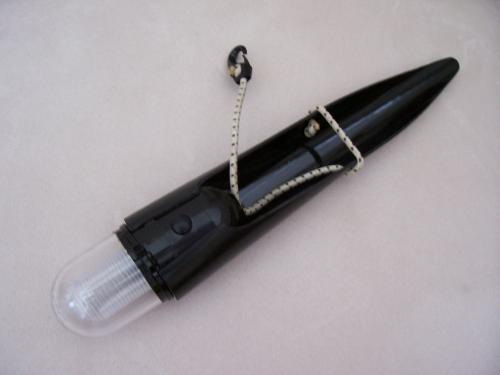  The point of the taper goes under the first hoop of lacing and the bungee is similarly hooked to the hoop and it all seems to be going according to plan –   As part of my Anger Management Programme, I’ve not actually lit this in anger yet, but I have hopes; mustn’t forget the torch. I’ve now used nearly two feet of about ten foot of pipe; So if your wondering where to Get some from… CW |
|
|
A long, long time ago
Do you still remember? In fact Polly Wee has been loved and sploshing around not infrequently in the last year and a half. You can tell she's been loved, because it's starting to wear the two-part polyurethane off her in all the important little places she and I come into contact with each other and the watery world she inhabits. Not yet the finished article and already time for a refit; such fun. I've discovered only quite recently that it is possible to capsize her when she has no ballast aboard, whereupon she lies on her beam ends quite peacefully, without totally inverting, courtesy of the light watertight yard, but is interestingly unstable once vertical again with a load of surging water sloshing about in the cockpit. The few gallons in the folds of the sail in its lifts, aggravated the situation, eventually joining me on board, (much of it via the neck of my foulies as I hoisted sail again). With water ballast aboard, she is also definitely and indignantly self-righting (bloop!) if I choose to leave the party, as I have also involuntarily managed while being tipped out by a heading-gust, which momentarily and viciously backed the main. But this is about evolution.... One of my delights is lying in my sleeping bag in the morning with my first cup of coffee; (and the second one). However things afloat are often at an angle and it isn't always constant, so a gimballed stove would relieve me of having to hold the coffee pot on the Camping Gaz for some minutes until it boils. Really, really tedious, by which time I am wide awake and have half dismantled the bunk with my other hand - bleah! I have a small gimballed item in my little gaffer - 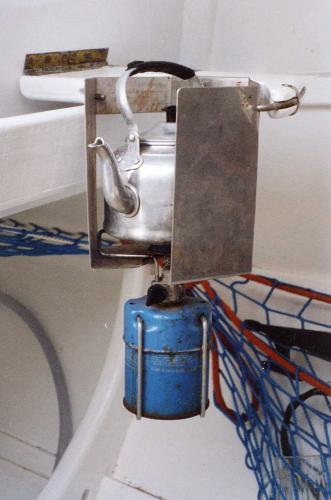 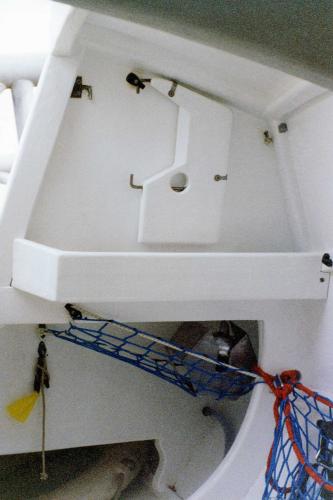 (Bad photo - the blue net and red line are not part of the operation at all) It folds away as can be seen and I have spent happy nocturnal hours pondering how to produce something similar that will not only function, but can be packed into some convenient yet negligible space while underway in this baby boat. Last night at about two-thirty or so, it suddenly came to me - take the gimbal arrangement and hang it up, you old goat! Too, too easy; so I did and with an only-lightly-adjusted wire handle, courtesy of Dulux, there are choices of location -  Under the cudulette Under the cudulette
 From the Pedyuloh stirrup eyes under the foredeck From the Pedyuloh stirrup eyes under the foredeck
Or even tie up the tiller and sling it right next to my sleeping torso, less than an arms length away  Oh stunning stuff I think I shall make myself a shorter version With fewer gaping holes, to prevent The escape of all those hot Little molecules CW COFFEEE! |
|
|
The downside of course to hanging it is that in a seaway (or even when one of those pesky motor cruisers goes past way in excess of the speed limit) the whole thing acts like a pendulum and goes into oscillation, spilling your coffee in the process.
You may need some damping (and I don't mean from the coffee onto your bunk) Simon |
|
|
You're right of course Simon
I also use a small solar garden lamp as an anchor light and recharge it during the day by hanging it under the boom, immediately behind the gooseneck. There it dances a merry dance as I sail along, threatening to destroy itself. A length of bungee reduces the ADHD to a mere restlessness and if you are right, then I hope that bungee will again come to the rescue. I'm so used to expecting disaster that I might even be ready to catch it before the thermodynamics spread beyond the coffee. It is interesting that maritime motorists take it for granted that they have the absolute right to create a wash. The wave formation off the back of a motor boat is so dissimilar to anything less than a minor tsunami in the natural world. It is sudden and utterly at odds to the natural order of what is going on around you. It drives me buggy that I can be easing a dinghy close-hauled along a shoreline (or Broadland river) and someone with the IQ of a fence post can take my hard-won impetus and without so much as removing their heads from their nethers, shake my boat to a standstill. IQ of a fence post? https://www.youtube.com/watch?v=BPPtrqvHGEg CW |
|
|
So, how did your Saturday afternoon go?
I narrowly escaped sinking at my Beale Park moorings, when my older Plastimo flexible (ballast) water tank sprang a leak in the middle of a good night's sleep. Fortunately I had closed the seacock, so was only woken by my bladder and noticed the odd angle of heel induced by free water in the bilges. I finally got to opening this can of worms just last week and decided that I was fed up with having to dismantle the whole thwart and bilge pump arrangement, simply to unscrew and remove the port side floorboard. Formally making it into two sections by cutting it in half under the thwart location would solve the problem. It is only 9mm ply, so it really needs all the integrity it can get; "ermm...?" How about angling the cut at 45 degrees and fixing a lippy-strip sort of thing under it? Not too big mind, as there's a lot going on under this side, which limits the amount of water-ballast room. Another 9mm strip, rounded underneath to avoid chomping into the flexible tank and forming a bird's mouth sort of slot, so that the aft end rests on the lip of the strip, while itself trapped under and thus supporting, the 45 degree cut of the forward end. Oh, jolly-dee! Unusually for me, I actually decided to clamp a straight edge onto the board to guide the cut, rather than my norm of drifty angled jigging along a pencil line by eye; this is the result -  Am I allowed to say "Well bugger!"? CW (I'll upload the result when I've sorted out the mess - epoxy filler to the rescue) |
|
|
How time flies
The port floorboard went in OK and is a load easier to remove and replace – 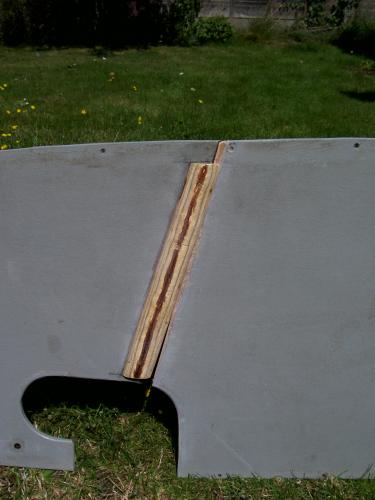 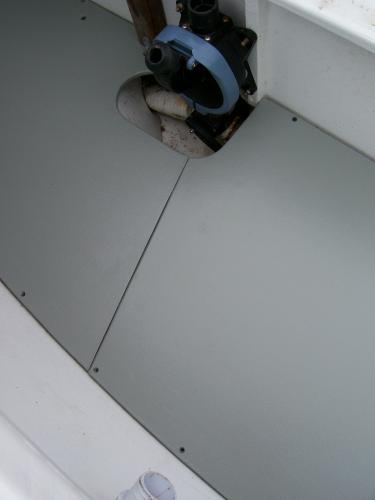 ….and there have been several other minor refinements; I was going to say ‘improvements’, but that is a matter of opinion. Some years ago I was trying to row a small sailing dinghy into a lock on the Thames, while clutching several parts of the rig that were determined to impede progress. I ended up in a shambles in some nearby reeds and it irritated me to be told by the lock-keeper that the easiest way to restrain the tiller while both hands are otherwise occupied was to have a length of bungee made off to somewhere central such as the aft end of the plate case, with an eye that could be slipped over a hook on the tiller to hold it elastically central, while the helmsman finds themselves with other stuff to do. Me; an old salt of many years experience! …. but he was absolutely right. Tiller-tamers, or whatever complicated thingummyjig you want, but this is dirt cheap, dead simple and works like a charm. Mainsheet freed off, my little boat settles down to the softest, softest forereaching heave-to; without this restriction, the tiller lurches to lee and the boat tends to loop up and down toward the wind. If you need an adjustment in mid-fiddle, then any old lower extremity will do to push the tiller off centre a tad and hold it there per chance – 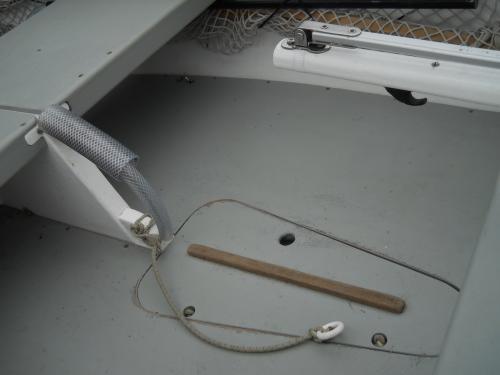 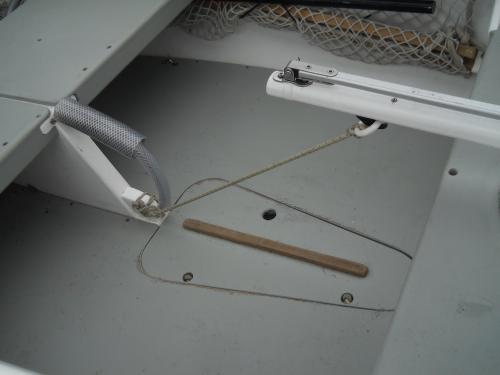 I’ve spent Polly Wee’s seven years sleeping under polypropylene when aboard and very noisy it has been on occasions; it really is too crackly for evening wear, particularly when the wind is up and for some time I’ve had some nylon tent material hesitatingly transmogrifying into a boom tent. Last month I finally had a first and rainy night under nylon; it’s a fairly dark grey from outside, but daylight sneaks through the stuff, so inside it is light, airy, quiet and dry – just the business. Note that the tent is specifically designed to cover the aft end of the spars; this is the highest point and it stops rainwater from running along the bundle and choosing some dry piece of bedding to drip on. It has taken several fittings and is still not quite right yet. Can’t really work out why, it’s only a flat sheet folded over the boom; anyone would think I was trying to clothe some voluptuous weather forecaster, or something –  
It has six tie-down points; lines from the corners of the two flaps at the stern pass through the tiller hole in the transom to clam cleats each side of the sternsheets. Amidships lines sewn to each side of the tent are passed through eyes on the side of the hull, up and over the gunwale to clam cleats under the side deck. Forward I wanted to have loops going to a central hook, but the angles tend to induce a gap between the side decks and the cuddy, so it seems as if there will need to be a couple of nylon hooks to clip onto deck-eyes each side, ahead of the cuddy itself. The only major problem with running the tent over the gunwales is potential friction damage if lying alongside something tough. Also trying to sling a fender suitably placed to prevent such damage, as the tent tends to get in the way of the fender’s lines. The other aspect is to produce a simple set of crutches that do not obstruct access to the cockpit. Having tried a number of options – the folding ‘X’ type and subsequently two versions of an inverted ‘U’ made from old windsurfer booms, I eventually snuck up on a stout piece of alloy tube – half a Mirror spinnaker boom and made it a reinforced hole though the stern deck with a peg on the stern-sheets underneath. It is slightly offset to Port, same as the balance lug and does not interfere with the tiller. The boom/yard/sail bundle is held at the top with a flexible hose which clips to an eye so that there are no pointy ends of any crutch to argue with the tent material. All good so far, though I have not discussed this arrangement with the yuloh – 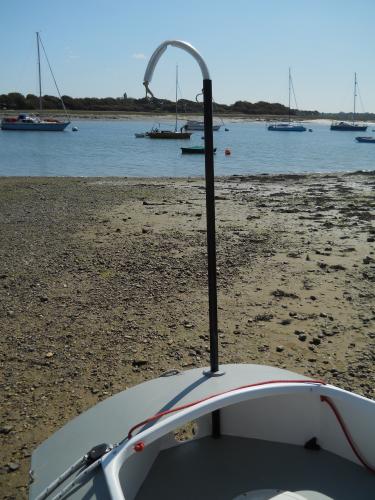 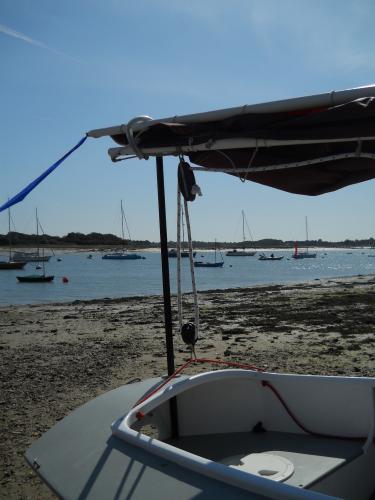 Note these pictures also show a (red rope) horse across the aft end of the cockpit coaming. Those of you who have sailed a Laser will know the mainsheet arrangement – one purchase on a rope horse across the stern deck with the final lead along the boom and down to a turning block aft of the dagger-board case. It’s a system that suits me, the only drawback being a tendency to snag under the corners of the transom on gybing. To minimize this, as shown above, I have moved the horse to the coaming on the forward edge of the stern deck, where it easy to grab and force a gybe and even an uncontrolled gybe does not usually end in a snarl-up. The disadvantage and there always is one, is that it is going to foul the yuloh system when I have both in situ for river work. I will not dismantle the old fittings, reverting to the original for inland waterways. I usually have at least one large fender on board to facilitate rolling her about on a beach, as well as softening hard moorings alongside. That’s one point; the other is that while she does self-right with the water-ballast onboard, she really wallows if swamped, ballasted or not. Now these two may not seem related, but the wallowing is aggravated by the lack of lateral buoyancy in the hull…. So, using one piece of equipment for three purposes, fender, roller and now for buoyancy, I lashed a fender down on the floor boards close to the chine each side and accidentally capsized again -  It worked quite well, though she seemed rather down by the bows when still on her side and proved it by arranging a swimming lesson for my old camera, which had till that moment been high and dry in net stowage inside the cuddy. Smaller fenders I think, forward and aft of the thwart on the cockpit floor close to each chine. Yeah, that should do it. I also foamed-in the under floorboard space, aft of the water ballast bags – 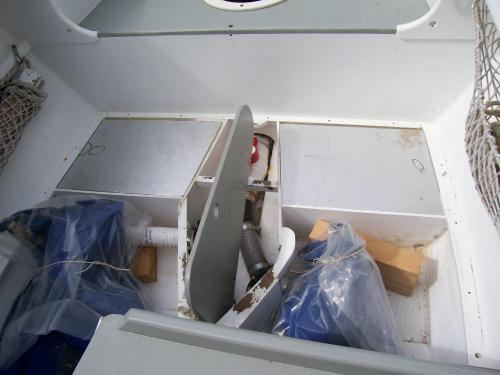
And lastly, I have finally fitted an anchor cleat to starboard on the foredeck, ahead of the cuddy, with reinforcing to the king-plank under the foredeck to take the strain. As I cannot easily reach the stemhead from the cockpit, I have an outhaul leading to the hawsehole there so that I can take anchor, or mooring lines to the bow. The outhaul also doubles up as a boom preventer for downwind work – 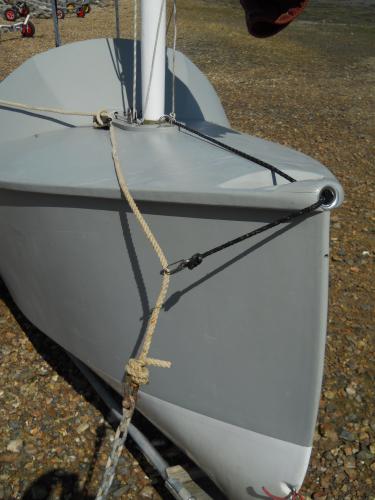 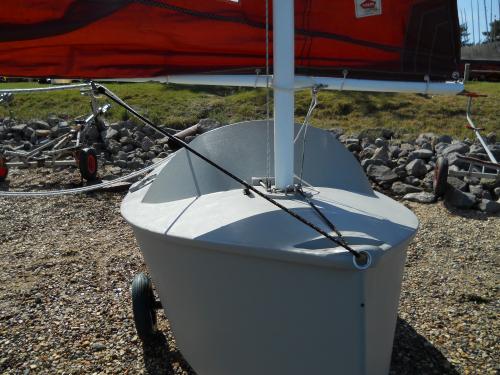 Perfection? Yes Sir, that's my baby; raiding dinghy Don't mean maybe CW But hold hard.... |
«
Return to Builds in Progress
|
1 view|%1 views
| Free forum by Nabble | Edit this page |

